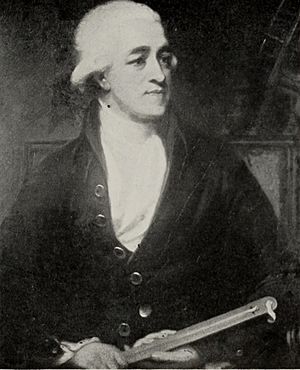George Shuckburgh-Evelyn facts for kids

Sir George Augustus William Shuckburgh-Evelyn, 6th Baronet (born August 23, 1751 – died August 11, 1804) was an important British person. He was a politician, a mathematician, and an astronomer. He helped us understand the stars and how to measure things accurately.
Contents
Sir George's Early Life and Family
George Shuckburgh was born on August 23, 1751. His father was Richard Shuckburgh from Limerick. George went to Rugby School and then to Balliol College, Oxford. He earned his first degree in 1772.
In 1773, his uncle passed away. George then became a "baronet," which is a special title. After traveling around Europe, he moved to Shuckburgh Hall. This was his family's big estate in Shuckburgh, Warwickshire.
Becoming a Member of Parliament
In 1774, George Shuckburgh became a Fellow of the Royal Society. This is a famous group for scientists.
From 1780 until he died in 1804, he was a Member of Parliament. This means he was a politician who helped make laws for Britain. He represented the area of Warwickshire in the House of Commons.
His Marriages and Children
In 1782, he married Sarah Johanna Darker. She was the daughter of John Darker. His second marriage was on October 6, 1785, to Julia Annabella Evelyn. She was the daughter of James Evelyn.
When his father-in-law died in 1793, George added "Evelyn" to his own last name. This is how he became Sir George Shuckburgh-Evelyn. Their daughter, Julia Evelyn Medley Shuckburgh, later married Charles Jenkinson, 3rd Earl of Liverpool.
Sir George Shuckburgh-Evelyn passed away on August 11, 1804. He died in Lower Shuckburgh, Warwickshire.
Sir George's Scientific Discoveries

Sir George was very interested in science. He made many important contributions to astronomy and how we measure things.
Contributions to Astronomy
He carefully watched the stars and planets. He wrote down his observations in twelve books between 1774 and 1797. In 1791, a special Shuckburgh telescope was put in his private observatory. This was at his home in Warwickshire, England.
He also measured features on the Moon's surface. Because of his work, a crater on the Moon is named Shuckburgh after him.
Work in Measurement (Metrology)
Sir George also helped with "metrology," which is the science of measurement. He studied how the boiling point of water changes with different air pressures. He showed why it's important to know this when checking thermometers.
He also had a standard brass "yard" made for him. This was called the Shuckburgh scale. It was used by scientists like George Biddell Airy to measure the Earth's shape. It also helped the British government set standards for many years.
Pioneering Price Indexes
In the field of statistics, Sir George was one of the first to put together "price indexes." These help us understand how prices change over time.
Awards and Recognition
He became a Fellow of the Royal Society in 1774. In 1798, he shared the Copley Medal. This is the highest award given by the Royal Society for scientific achievements.


